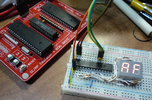Mike - K8LH
Well-Known Member
Just wondering if anyone has tried Jaakko Kairus' PICKITminus project to upgrade the Stand Alone Programming App' for their PICKIT 2 or PICKIT 3 to program many, many, almost all (?) PIC devices?

Also, back in 2020 I asked if there was a way to avoid buying an expensive PICKIT 4 to program an 18F27Q43. Recently, after studying Jaromir Sukuba's A-P Programmer code, I've been able to use a relatively inexpensive Arduino Nano clone to read/write/program 18FxxQ40, 18FxxQ41, and 18FxxQ43 devices in LVP (Low Voltage Programming) mode. Fun stuff but I could use a hand writing a Windows "front end" to manage file transfer to/from the Arduino.
Cheerful regards, Mike, K8LH

Also, back in 2020 I asked if there was a way to avoid buying an expensive PICKIT 4 to program an 18F27Q43. Recently, after studying Jaromir Sukuba's A-P Programmer code, I've been able to use a relatively inexpensive Arduino Nano clone to read/write/program 18FxxQ40, 18FxxQ41, and 18FxxQ43 devices in LVP (Low Voltage Programming) mode. Fun stuff but I could use a hand writing a Windows "front end" to manage file transfer to/from the Arduino.
Cheerful regards, Mike, K8LH

